London- A trail of 5.7 million-year-old fossil footprints discovered in Crete could upend the widely accepted theories on early human evolution. The new prints have a distinctly human-like form.
The Daily Mail reported that the prints were found in a type of sedimentary rock that formed when the Mediterranean Sea briefly dried out, 5.6 million years ago.
It continued that at this time, it’s thought human ancestors were in Africa, with ape-like feet. The find suggests a previously unknown species may have existed in Europe, and that this early primate convergently evolved human-like feet.
Professor Per Ahlberg at Uppsala University, one of the authors on the new study said: “What makes this controversial is the age and location of the prints.”
Studies in recent decades have led to the conclusion that all fossil human-ancestors older than 1.8 million years lived and evolved in Africa. But, the new fossil footprints are not the oldest hominin evidence to be found, but they could drive a wedge in the timeline of evolution.
It’s thought that human ancestors of the last few million years directly derived from a genus known as Ardipithecus.
A set of complete 4.4 million-year-old Ardipithecus fossils discovered in Ethiopia was found to have an ape-like foot, it was thought that the human-like foot had not yet evolved by that time.
Several other fossil discoveries in South and East Africa have further supported the idea that the evolution of human bipedalism took place on the continent, including the 3.7 million-year-old Laetoli footprints from Tanzania, providing evidence of human-like feet and upright locomotion.
According to the new study, however, the new footprints discovered in Trachilos have a human-like form.
Researchers asserts in their study, which was published in the journal Proceedings of the Geologists’ Association that the interpretation of these footprints is potentially controversial.
This knowledge, coupled with dating methods based on marine microfossils, indicates that the prints are about 5.7 million years old. The shape of the fossil prints suggests the suspected hominin who left them was more primitive than the Laetoli.
While the Trachilos prints were created on the sandy shore of the Mediterranean, the Laetoli tracks were made in volcanic ash. The researchers now say that during this time, before modern day Crete detached from the Greek mainland or the Sahara Desert even existed, early hominins could have lived across southeast Europe as well as Africa.
Per Ahlberg noted that this discovery challenges the established narrative of early human evolution head-on and is likely to generate a lot of debate, and whether the human origins research community will accept fossil footprints as conclusive evidence of the presence of hominins in the Miocene of Crete remains to be seen
